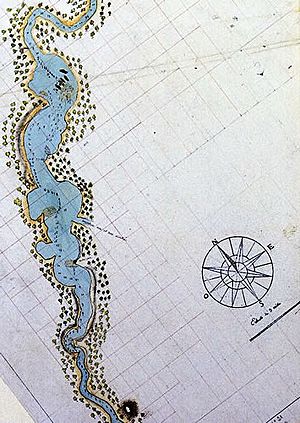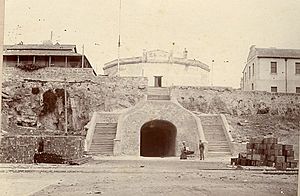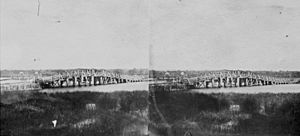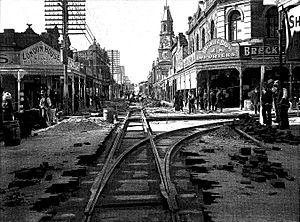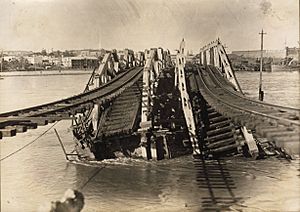History of Perth, Western Australia facts for kids
Perth was started by Captain James Stirling in 1829. It was the main town for the Swan River Colony. Perth became a city in 1856. It got its name because Sir George Murray, a politician from Perthshire, had a lot of influence.
Contents
Aboriginal History of Perth
Before the Swan River Colony began, the local Noongar people lived here. They were hunters and gatherers. They called the area where Perth now stands Boorloo. This was part of Mooro, the land of Yellagonga's group. They were one of several groups called the Whadjug living around the Swan River.
The lakes on the coastal plain were very important to the Aboriginal people. They provided food, meeting places, and hunting grounds. Fish, turtles, birds, eggs, and plants were plentiful. The swamps also offered natural spaces for ceremonies and camping.
From 1831, there were fights between settlers and Noongars. This led to some sad events and the Noongar people moving to the swamps and lakes north of the river. These areas, known as Boodjamooling, became their main camps after they lost their traditional lands.
Early European Visits
Europeans first explored this area in 1697. Dutch captain Willem de Vlamingh discovered the Swan River. He sailed up the river but was not impressed with the land. French explorers in 1801 and British explorers in 1822 also found the area unsuitable for settlement.
Captain James Stirling was the first explorer to like the Swan River. He explored it in March 1827. Stirling had family connections to the powerful British East India Company. He thought a West Australian colony could be good for trade with India.
Stirling, along with Frederick Garling and botanist Charles Fraser, spent 12 days exploring the river. They went as far as the Ellen Brook area. They did not go far enough inland to see that much of the soil was sandy. So, their good opinion of the soil was not quite right. However, this opinion helped decide to start the Swan River Colony.
Stirling told the British government that earlier explorers found the area "sterile" (barren). But he argued it was better than New South Wales. He spoke highly of its farming potential. He wanted a free settlement, not a prison colony like others in Australia. The government agreed in October 1828. They thought it would not cost much, and they heard the French might start a colony there.
Starting the Swan River Colony
The first settlers arrived in June 1829. They landed on the sandy beaches north of the Swan River. No one had prepared the land or built any houses. The settlers put a lot of pressure on Stirling's Surveyor-General, John Septimus Roe. He quickly started marking out land along the river. The best farming land was upstream, not very far from the Swan and Canning Rivers. The area of Guildford had the best soil and was settled in the first year.
Planning the Main Towns
John Septimus Roe planned the towns of Perth, Fremantle, and Guildford. Fremantle was the port city for ships entering the colony. Guildford was where farm goods were loaded onto boats to go down the Swan River. Perth was the centre for government and military. All three towns grew slowly at first.
Perth's boundaries were the Swan River to the south and east. Mount Eliza was to the west. A line of swamps and lakes was to the north. The spot was chosen because it had fresh water and river transport. There were also building materials and good views of the Darling Scarp. Mount Eliza also offered protection. The official founding ceremony happened on 12 August 1829. Helen Dance, Captain William Dance's wife, chopped down a tree. A plaque on Barrack Street marks this event.
Early Years (1830 - 1850)
Much of the land around Perth was sandy and not good for farming. This meant early reports about the colony were not very positive. This, plus the hard work of clearing land, made Perth grow slowly for the first 20 years. Farming developed further away, in places like the Avon Valley.
Early transport was mostly by boat along the coast and rivers. One of the first big projects was a 280-metre canal. This created Burswood Island. Two years later, in 1833, the first dirt track was cut between Perth and Fremantle. Other tracks followed to areas like Kelmscott and Mandurah. The first bridge was a simple timber causeway across the Swan River. It connected what are now East Perth and Victoria Park.
Early buildings helped set up the colony's government and society. In 1831, the Round House prison was finished. The Court House opened in 1836. It was also used as a church until St George's Church was built in 1842. The first church was actually All Saints Church in the Swan Valley, finished in 1841. The colony's first brewery, Swan Brewery, opened near Mount Eliza.
Relations between Europeans and Aborigines were sometimes difficult. On 11 July 1833, a senior Aboriginal warrior named Yagan was killed. This happened after a reward was offered for his capture.
By 1850, the population of Western Australia was 5,886. Perth's population was still only about 1,940, similar to Fremantle's.
Convict Era (1850 - 1868)
In 1849, after slow growth, Perth became a penal colony. Over the next 16 years, more than 9,000 convicts arrived. This greatly changed the colony's society and economy. Convicts built a lot of important structures. This shaped the city's look.
Perth's early buildings were simple. But with convict workers, new, grander government buildings appeared. These showed the style of the British Empire. They were mostly built in the Gothic style popular in England then. They used local clay bricks. Buildings from this time include Fremantle Prison, Government House, Perth Town Hall, The Cloisters, and Perth Gaol.
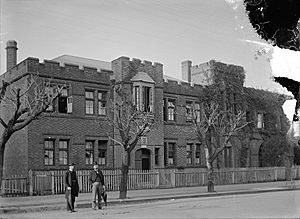
The convict workers helped the colony grow. However, Perth still felt like a small, remote town. Even though Queen Victoria declared it a city in 1856, a journalist in 1870 described Perth as: "a quiet little town of some 3000 people spread out in scattered areas down to the water's edge, mixed with gardens and bushes and looking half rural... The main streets are paved, but the outer ones and most footpaths are still loose sand." This village-like feel, with scattered brick or stone houses and gardens, stayed the same until the 1880s and 1890s.
Later 19th Century
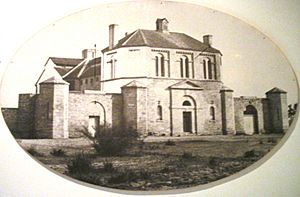
The late 1800s, especially the last two decades, saw Perth begin to grow a lot. In 1877, a telegraph line from Adelaide to Perth was finished. This made communication across Australia much better. It also helped local newspapers grow, like the Western Mail, which started in 1885.
Government buildings continued to shape the city centre. In 1874, large government offices were built. They housed the Cabinet, Treasury, and Post Office. The business area slowly grew with shops and small houses west of Barrack Street.
Two big events greatly changed Perth and its surrounding areas: the building of a railway from Fremantle to Guildford in 1881, and the Western Australian gold rushes, starting in 1885.
Gold Boom (1885 - 1895)
Gold was found in the Kimberley, Murchison, and Kalgoorlie regions in the 1880s and 1890s. At the same time, Western Australia gained responsible government in 1890. These events had a huge effect on Perth. The city changed a lot due to new wealth and more people arriving because of the gold rush. In just ten years, the city's population tripled. It went from 8,447 in 1891 to 27,553 in 1901. By the early 1900s, Perth looked completely different. Its streets had many fancy multi-storey buildings. Many were designed by a growing number of architects. The population also spread into new suburbs around the city.
The location of the central Perth railway station greatly influenced how land was used in the city. The railway line formed a boundary to the north. Government buildings were to the south. This meant businesses and offices were built mainly in the city's middle, between William and Barrack Streets. This created a lively area that people could walk around and reach by public transport. It is still like that today.
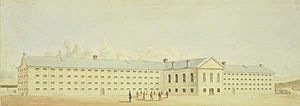
More people meant more need for roads, services, and facilities. However, these did not always grow fast enough. In 1893, Perth got electricity. The suburban train line was also extended to Armadale that same year. In 1898, the Perth Zoo opened.
In 1897, Fremantle Harbour officially opened. This allowed larger ships to enter the Swan River. It was made possible by blasting a rocky bar at the river mouth. This work was led by the colony's chief engineer, Charles Yelverton O'Connor.
On 28 September 1899, the first electric tram services began. They ran from East Perth along Hay Street. The Perth Mint, also on Hay Street, opened the same year.
Early 20th Century
In 1902, Claremont Teachers College in Claremont became Western Australia's first college for higher education.
In 1903, a pipeline from Mundaring Weir to Kalgoorlie opened. This was a huge achievement for its time. It was built under the direction of C. Y. O'Connor.
In 1911, the University of Western Australia became Perth's first university. Classes started in 1913. The first campus was on Irwin Street.
In July 1926, the Swan River flooded badly. The Fremantle Railway Bridge collapsed just after a train crossed it. The Upper Swan Bridge was also damaged.
On 12 August 1929, Perth celebrated 100 years since British settlement.
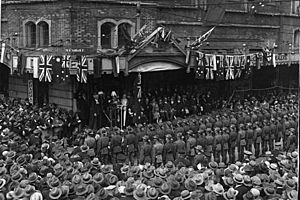
In 1930, telephone services connected Perth to Adelaide and then to eastern Australia.
In 1932, the University of Western Australia moved to its current location in Crawley.
During World War II, Fremantle was a base for submarines. In 1943, a US Navy Catalina flying boat fleet was based at Matilda Bay. American, Australian, and Dutch pilots used the Swan River for training. They flew missions as far away as Ceylon.
Post-War Period (1946 - 1970s)
After the war, many European immigrants came to Australia. About 240,000 moved to Perth between 1946 and 1970. Before the war, only a small part of Perth's population was from non-English speaking countries. By the 1970s, 21% of Perth's people were born overseas. Many came from Italy, Holland, and Germany.
Later 20th Century
In 1955, Gordon Stephenson and John Alistair Hepburn created a plan for Perth and Fremantle.
In 1958, Perth's trams stopped running. They could not compete with buses and cars.
The Narrows Bridge opened in 1959. It connected the north and south sides of the Swan River. At the time, it was the largest bridge of its kind in the world.
The 1960s and 1970s saw Perth continue to grow. This was helped by discoveries of iron ore and natural gas in the state. The city's skyline changed a lot with the building of Perth's first skyscrapers.
On 20 February 1962, Perth became known as the "City of Light." City residents turned on their house lights and streetlights. This was to celebrate American astronaut John Glenn orbiting the Earth. The city did it again when Glenn passed overhead in the Space Shuttle in 1998.
In 1962, Perth hosted the British Empire and Commonwealth Games. Events were held at Perry Lakes Stadium and Beatty Park Aquatic Centre. Both places were built for the games.
In 1969, Perth's trolleybuses also stopped running.
In 1970, the first Test Cricket match in Perth was played against England.
On 17 September 1974, Murdoch University, Perth's second university, opened. Classes began in 1975 with 510 students.
In 1979, the WAY '79 celebrations marked Perth's 150th anniversary of European settlement. The city hosted the Miss Universe competition as part of the celebrations.
In 1979, the Fremantle railway line closed because not enough people were using it. It reopened in 1983 after a change in government.
On 26 September 1983, Australia II won the America's Cup yacht race. This was the first time a challenging team had won it in 132 years. Even though the race was in the USA, it was a big day for Perth. Perth businessman Alan Bond helped pay for the Australia II challenge. After winning, Perth had four years to get ready to defend the cup in 1987. During this time, Fremantle especially grew a lot.
In 1985, the Burswood Casino, Perth's only casino, opened. The resort opened in 1988.
In 1987, the city hosted the defence of the America's Cup but lost.
In the 1980s, a political issue known as WA Inc caused a loss of public money. Some large Perth businesses faced financial trouble. A special investigation found that the state government had made business deals with prominent businessmen. As a result, some former leaders faced consequences for their actions.
In 1992, the Joondalup railway line opened to the northern suburbs. This was the first new suburban passenger railway line in Perth in 103 years. This line mostly runs along the middle of the Mitchell Freeway.
In 1995, the French Consulate in Perth was attacked.
21st Century
Since at least 1966, Perth's population has grown faster than the national average. In the early 2000s, it became Australia's fastest-growing capital city. This was due to the West Australian mining boom. From 2001 to 2011, the city's population grew by 346,000 people. Most of this growth happened in the outer suburbs. These include the City of Wanneroo and the southern coastal suburbs. Perth has attracted many skilled migrants from the UK and South Africa. Major new projects included the $1.6 billion New MetroRail project, which doubled the size of Perth's train system. The Graham Farmer Freeway and Roe Highway were also built.
Some important recent events include:
- 2008: The ban on uranium mining was lifted by the new government.
- 22 March 2010: Storms caused millions of dollars in hail damage. They left 150,000 homes without power.
- October 2011: Perth hosted the Commonwealth Heads of Government Meeting. The Queen also visited.
- 2012: Construction of Brookfield Place was finished. This skyscraper is the second tallest in Western Australia.
- 2012: Work began on Elizabeth Quay. This is a big project to redevelop the Perth waterfront.


